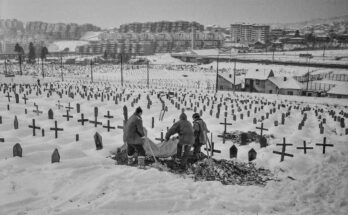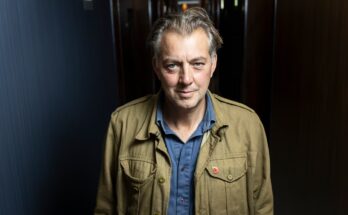At the age of 23, Simon Rattle compared the role of BBC conductor to that of someone who always orders for everyone in a Chinese restaurant. For him the dictatorship of the podium belongs to the past. His approach has always been deeply collaborative, because “we do a strange job: we don’t produce any sound”, he often recalls.
Now, about to turn 71, he considers each orchestra to be a big family. He spent nearly two decades at the helm of the City of Birmingham Symphony, more than three decades guiding the destinies of the Berlin Philharmonic and six years as principal conductor of the London Symphony. But he has just visited Madrid with his new family, the Bavarian Radio Symphony (BRSO), which he has directed since 2023, and was surprised by his affectionate gesture when he approaches, at the end of each work, each instrumentalist to thank him personally for his dedication. “We must take care of each other,” he often repeats.
The European tour with which the BRSO closes 2025 has a strong emotional component for the English director, despite having adopted German nationality as a sign of rejection of Brexit. It began on November 10th with a concert in Liverpool, his hometown and place of education until the age of 16; He continues in Birmingham and London, two fundamental stages of his career, as well as in Paris, Frankfurt, Cologne and Luxembourg. However, the only city that hosted both tour programs was Madrid, on the 19th and 20th, within the two series of Ibermúsica. Today, November 21st, they will perform in Barcelona and tomorrow, the 22nd, they will put an end to the tour in Valencia.
At the end of yesterday’s concert, Rattle expressed his satisfaction with returning to Madrid and offered the only takeaway from his two performances. The spinnerfrom the suite Pelléas and Mélisandeby Gabriel Fauré. A fascinating finale, with those violins that evoked the buzz of the spinning wheel and the lyrical outbursts of the wind, guided by the oboe. Moments earlier, in the second part of Thursday’s concert, we had heard the musical highlight of Rattle and the BRSO’s two-day Madrid performance: a truly unforgettable performance of the entire 1910 ballet The firebirdby Igor Stravinsky.
The Bavarian orchestra showed a superhuman category from the first bars, generating a disturbing atmosphere that evoked the night, with the pianissimo low strings displaying a tritone in F minor. However, the true potential of the ensemble went far beyond the individual virtuosity of its members: the narrative force achieved under Rattle, who conducted without a score, was fascinating. The show’s fifty minutes passed in a flash, captivating the audience with Prince Ivan’s adventures in the kingdom of the evil sorcerer Katschei.
We see this in the emergence of the magical world, symbolized by the bird, through octatonic scales, exquisite wooden solos and the constant fluttering of the string, accompanied by piano arpeggios and glissandi of the harp An ideal representation of the natural dimension, expressed with the refined flute of Henrik Wiese and the emotional charge of the excellent harp solos first violin Anton Barakhovsky. The version has not lost an ounce of lyricism upon returning to the human world, in the prince’s love story with a captive princess, where Stravinsky quotes his teacher, Rimsky-Korsakov.
Rattle intensified the irruption with the trumpets of dawn and the entrance of the malevolent Katschei accompanied by his retinue of monsters. The display of orchestral strides and irregular rhythms allowed the ensemble’s impressive brass and percussion to shine. We could also see the four muted Wagnerian tubas, which usually play backstage, to recreate the magical carillon (fairy music box) which triggers the conflict. The contrast between the hellish dance and the lullaby was overwhelming. Likewise, Katschei’s death was insurmountable and culminated in a tense pianissimo tremolo from the strings that left the audience breathless. Then, Carsten Duffin’s horn solo broke the evil spell and the rest of the very short second frame was simply apotheotic.
The concert on Thursday 20th opened with a captivating version of Symphony no. 2composed in 1846 by Robert Schumann. A game of contrasts very similar to the style of Rattle, who strengthened his nineteenth-century Germanic symphonic repertoire during his period at the helm of the Berlin Philharmonic, delving into Schumann and Bruckner without ever abandoning his usual references to the twentieth century, with particular attention to Stravinsky and Janáček.
In Schumann’s symphony the powerful strings of the BRSO stood out, solidly supported by one of the best double bass sections in the world. Rattle offered, however, a fairly contained reading, taking a particular interest in the ghosts that populate this score. This was clearly felt in the grieving person. expressive adageinitially imbued with a Bachian aroma, followed by a precise evocation, shortly before the recapitulation, of the famous scene of the armed men from the second act of The Magic Flute by Mozart.
Nor did Rattle manage to convince with his version of the Symphony no. 7completed by Anton Bruckner in 1883, performed on the 19th in the second part of the concert. He is a composer whose repertoire he has deepened significantly in recent decades, but it is also the symphony that fascinated him in his youth, when he performed it under the direction of Rudolf Schwarz, as recounted in Nicholas Kenyon’s book. Rattle, however, has not yet found an authentic Brucknerian streak, despite having an exceptional orchestra in each of its sections.
The first movement sounded confident, although without any real conflict in development, with a Bavarian orchestra conveying a feeling of excessive comfort. The famous dark and solemn tone of the slowlyconceived as an homage to Wagner, it lacked mystical depth. The dancing air he gave to the joke It was soft and tension-free. And in finalalthough he nimbly weaved the multiple ideas together, he did so without the solemnity or grandeur necessary to culminate in that celestial ascent that this composition requires.
But the concert on the 19th reached its climax in the first part with the rhapsody Taras Bulba by Leoš Janáček, completed in 1918 based on the novel of the same name by Nikolái Gógol. Rattle established himself once again as an admirable storyteller, master of all the Czech composer’s musical inflections and his incisive orchestration. This was evident in the first movement, Andrei’s deathwhere he recounts the betrayal for love and the subsequent execution of one of his sons, fascinated by the haunting melody of Tobias Vogelmann’s English horn over a pulsating string accompaniment, to which the Granada oboist Ramón Ortega Quero responded. The contrast with the violence of the Cossacks, punctuated by the din of cymbals and trombones, was impeccable.
In the second movement, death of Ostapcentered on the death of Tarás Bulba’s other son, the haunting rhythms and heartbreaking clarinet screams flawlessly evoked his grief, in stark contrast to the jubilant mazurka danced by his Polish executioners. And in the third movement, death and prophecy of Taras Bulbawhere we witness the execution of the protagonist, burned alive, once again highlighted the tension and play of contrasts, now with a Krakow dance, while Rattle masterfully crowned his final climax with organ and brass.
Hypermusic, 25-26. Barbieri and Arriaga series
Works by Leoš Janáček, Anton Bruckner, Robert Schumann and Ígor Stravinski.
Bavarian Rundfunks Symphony Orchestra.
Simon Rattle (director).
National Auditorium of Madrid, 19-20 November.



